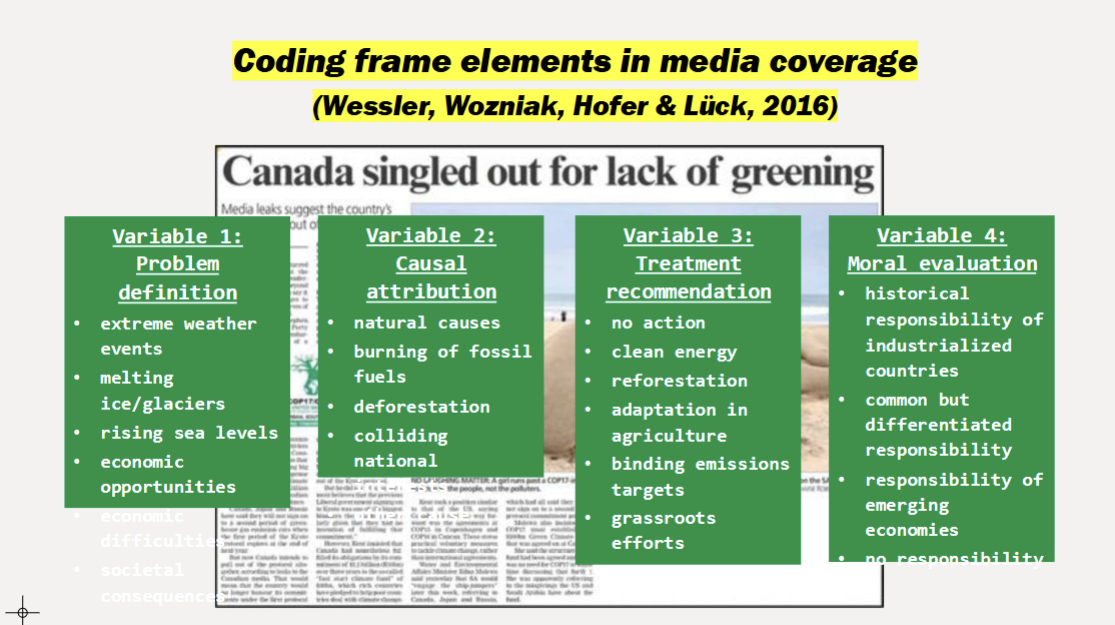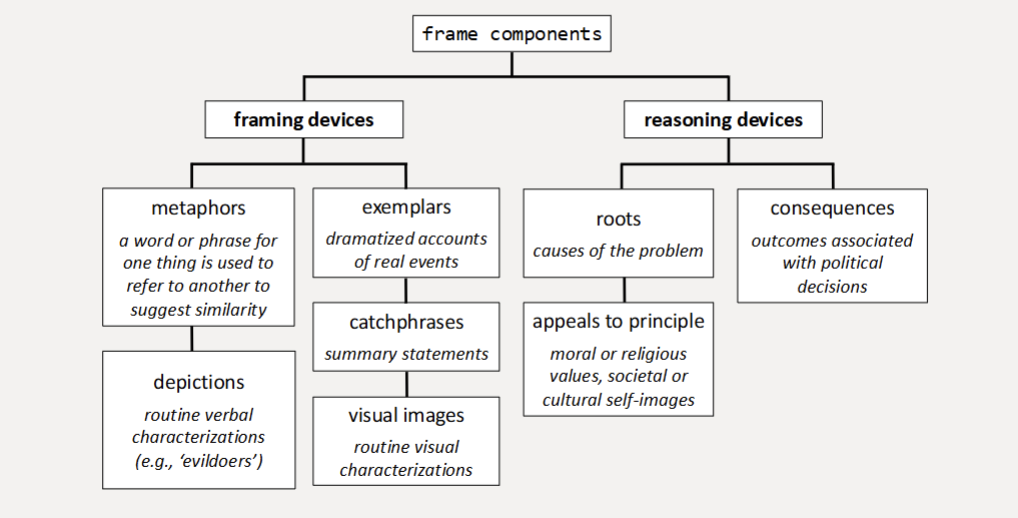Content Analysis & Media Framing (5)
1/19
There's no tags or description
Looks like no tags are added yet.
Name | Mastery | Learn | Test | Matching | Spaced |
|---|
No study sessions yet.
20 Terms
Content Analysis
A systematic, replicable technique for compressing many words of text into fewer content categories based on explicit rules of coding (Berelson, 1952; Krippendorf, 1980; Weber 1990)
Enables researches to sift through large volumes of data with relative ease in a systematic fashion (Mayring, 2000)
Uses of Content Analysis
Describe trends or patterns in communication content (ex. news, advertisements, movies)
To compare media and levels of communication (ex. British vs French news about COVID-10; tabloid vs. broadsheet coverage of the Royal Family)
To audit communication content against objectives (ex. is the BBC giving voice to a wide spectrum of actors and interests?)
To expose propaganda techniques (ex. US media on the “war on terror” or Russian state media on the Ukraine war)
What counts as a text?
Any sort of recorded communication
Books, newspaper articles, historical documents, medical records, web sites, speeches, plays, tweets, television programs, sketches and drawings, informal conversations, interviews, classroom discussions, lectures, and manifestos of political parties
Qualitative content analysis
Focuses on the characteristics of language as communication with attention to the content or contextual meaning of the text (Bryman, 2008)
A research method for the interpretation of the content of text data through the systematic classification process of coding and identifying themes or patterns (either using an existing category system or a “grounded theory” approach where categories emerge through an iterative analysis)
Quantitative Content Analysis
Focus on manifest content
ex:
Number of times a certain politician is mentioned (ex. “Keir Starmer” or “The Prime Minister”)
How often the term “illegal” is used to describe immigrants and asylum seekers
Not trying to understand the meaning of it more like "How often does Donald Trump mention fake news" - trying to understand numerically
The percentage of news photos of protests that also show police or destruction
Also allows to infer latent constructs — ex. framing or bias — from measuring manifest content
Media Framing (Goffman, 1974)
Sociological Perspective
A focus on how individuals interpret and make sense of the world through structures provided
Social objects are viewed through a series of laminations or keyings which change meanings, recontextualize them. They add, or take away meaning
Basis of framing theory is that the media focuses attention on certain events and then places them within a field of meaning.
Example – the way we frame them or discuss them changes the way we understand them
Undocumented worker vs illegal alien
Pro-choice vs. Pro-abortion
Accuser vs. Victim
How framing effects work (Chong & Druckman, 2007)
Psychological preconditions of ______ _______:
People draw their opinions from the set of available beliefs stored in their memory
Only some beliefs become accessible at a given moment
Out of the set of accessible beliefs, only some are strong enough to be judge relevant or applicable to the subject at hand
_______ _______ can work on all three levels by:
Making new beliefs about an issue
Making certain available beliefs accessible; or
Making beliefs applicable or “strong” in people’s evaluations
Framing (Entman, 1993)
Determine whether most people notice and how they understand and remember a problem, how they evaluate it, and how they choose to act upon it
Select and call attention to particular aspects of the reality described - and simultaneously direct attention away from other aspects → most framed are defined by what they omit as well as include
They define problems (determine what a casual agent is doing with what costs and benefits
Diagnose causes (identify the forces creating the problem)
Make moral judgements (evaluate causal agents and their effects)
Suggest remedies (offer and justify treatments for the problems and predict their likely effects)
Frames have how many locations in the communication process?
4 locations
The communicator
The text
The receiver
The culture
How to analyse framing (Entman, 1993)
The Problem Definition - how the issue/problem is portrayed and defined in media discourse. Media framing can influence which aspects of an issue are emphasized as problematic and which are downplayed and ignored. The framing of the problem can shape how audiences perceive its significance and potential solutions
Diagnose Causes - point of analysis - how does the media attribute causes or reasons the the problem being discusses?
Moral Judgement - Media framed can shape perceptions of who or what is responsible for the problem and whether certain actions or behaviours are considered acceptable or condemnable. Moral evaluation influences how audiences perceive the issue and potential responses to it
Treatment/Remedies - examining the proposed solutions or responses to the problem presented in media discourse. Framing can influence which strategies or policies are portrayed as effective or desirable in addressing the issue. Treatment recommendations can shape public opinion and policy debates by framing certain approaches as more feasible, desirable, or legitimate than others

The Study of Media Framing (Tankard, 2001)
Framing a helpful approach to the study of ideology in media representations (transcending the concepts of “bias” and “objectivity”; Hackett, 1984)
Power of framing comes from its ability to define the terms of debate (often without the audience realising this is taking place)
Three major metaphorical uses of frame concept
Frames isolate certain material and draw attention to it (“strips” of the everyday world)
Frames set a tone for an event or issue
Frames are the organizing ideas on which a story is built
The Content Analysis of Media Framing (Matthes & Kohring, 2008)
Hermeneutic approach
Linguistic approach
Manual Holistic approach
Computer-assisted “Frame Mapping”
Deductive approach
Hermeneutic Approach (Matthes & Kohring, 2008)
Tries to identify frames by providing an interpretative account of media texts linking up frames with broader cultural elements (qualitative; questions about robustness of findings are selection bias)
Linguistic Approach (Matthes & Kohring, 2008)
Frames are identified by analysing the selection, placement, and structure of specific words and sentences in a text (use of structural dimensions such as syntax, script, theme, and rhetoric)
Manual Holistic Approach (Matthes & Kohring, 2008)
Frames are first generated by a qualitative analysis of some news texts and then are coded as holistic variables in a manual, quantitative content analysis (but often fail to name criteria for initial frame identification)
Computer-assisted “frame mapping”
Finding particular words that occur together in some texts and do not tend to occur together in other texts (reduced frames to cluster of words; story topics instead of frames)
Deductive Approach (Matthes & Kohring, 2008)
Frames derived theoretically from the literature and coded in standard content analysis (limited to already established framed)
Hermeneutic Frame Analysis (Gamson & Lasch, 1983; van Gorp, 2007)

Frames as clusters of frame elements (Matthes & Kohring, 2008)
Code previously defined elements or components of frames in a media content analysis ex. problem, causes, treatments, moral evaluation
Cluster analysis of frame elements ex. some elements group together systematically in a specific way -→ pattern can be identified across text from the media sample → these patterns can be understood as media frames
Benefits
Coding single frame elements achieves a higher reliability in comparison to coding abstract, holistic frames
Weaker impact of coder schemata or coding expectation
New emerging frames can be easily detected